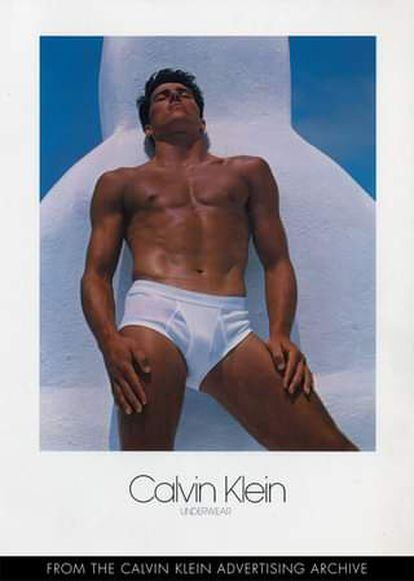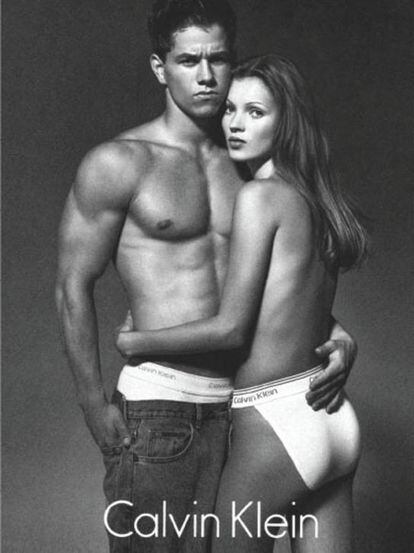In the early eighties, Calvin Klein was already a figure in New York. Creator of “designer” jeans, he was a regular at Studio 54 along with Grace Jones, Donna Summers, Salvador Dalí, Cher and Warhol and was about to patent minimalism in fashion. By that time, the designer already knew two things: first, that sex sells, something he confirmed in 1980 when he placed a fifteen-year-old Brooke Shields in front of Richard Avedon's lens with erotic insinuations (“Do you want to know what comes between me?” Calvins and me? Nothing,” the ad read.
The controversy unleashed managed to sell thousands of jeans just hours after the launch. The second lesson that Mr. Klein had already learned was the power of the image: “The only way to advertise is not to focus on the product.” said on one occasion. Thus, on these two pillars, the American designer turned underwear into an emblem of status, its wearers into sexual symbols, and his brand, which he had launched with just $10,000 in 1968, into a photograph of popular aspirations for fashion. over the following decades. Today his campaigns continue to have an impact, and spark controversy: Jeremy Allen White (The Bear) has starred in the firm's latest viral advertisement and the British singer FKA Twigs has regretted the withdrawal of the advertisement in which she stars in the United Kingdom, where it has been accused of showing an “excessively sexualized” image of the artist: “I don't see the ' stereotypical sexual object' with which I have been labeled. “I see a beautiful, strong black woman whose incredible body has overcome more pain than you can imagine,” Twigs said on her Instagram account. instagram.
They are not the only images of the company that have caused people to talk throughout its history. Calvin Klein debuted with its first underwear advertisement in 1982. The Underwear line, launched that same year, was Klein's big commercial bet (the women's line would arrive a year later) and the American knew that it needed a campaign that would place it in the spotlight. collective imagination. So it was.
The chosen one was a man as prodigious in sport as at first glance: the pole vaulter and Olympic athlete of Brazilian origin Tom Hintaus. The photographer was the legendary Bruce Weber (born in 1946 outside of Pittsburgh, and at that time a renowned photographer of GQ and Vogue) and the session took place in Santorini: the athlete appears, like a Greek god, leaning on the typical white stone of the island dressed only in white underwear on whose waistband you can read the brand. The pose is analyzed by gender studies expert David Coad in his book The Metrosexual: Gender, Sexuality, and Sport. YesAccording to this author, the posture was reminiscent of the Greek statues of the Archaic Period, the so-called Kouroi, which were “large sculptures of naked male bodies that served as devotional offerings to the gods.” Shortly after, Hintaus's image arrived in New York in a big way, literally, with a poster 40 meters long by 15 meters wide displayed in the middle of Times Square. Calvin Klein also wallpapered bus stops throughout the city with the advertisement and what happened next perfectly narrates the euphoria that the announcement unleashed: numerous bus shelters were vandalized, and the poster was stolen.
That image decreed that underwear was more than underwear: Calvin Klein's white briefs were designed to be seen (in fact, in the following years the trend of showing the waistband with the brand was greatly favored by the fashion of pants. low-rise jeans), but they also conferred status. They were totemic underwear.

How to analyze The New Yorker, Hintaus's images had a grandeur greater than was evident: the advertisement evoked a fetish of the gay male subculture of the 1980s, such as tight white underwear, and, furthermore, the celebration of men as sexual objects reflected the growing visibility of homosexual culture. “What had been hidden inside the adult movie theaters of Times Square was now out in public and on a pedestal,” Coad writes in his book.
In the following years, Calvin Klein underwear campaigns became a recognizable visual element of the image of Manhattan, like yellow taxis, and even the New York magazine dedicated a tribute to them through a cover in 1994.
The Hintaus campaign was the first to create a visual language with identifiable coordinates (star photographer, protagonist chiseled with pheromones, white underwear) that defined advertising and fashion in the following years, until reaching the campaign starring Jeremy Allen White this year. same 2024.
With campaigns like those of Calvin Klein, advertising in the 1980s experienced a revolution in messages, language and aesthetics. Suddenly the claims of underwear advertisements began to be modern and creative, more suggestive and daring, they included desire as a common element and opened the door to a new masculinity. While Hintaus revolutionized New York, in Spain they were the golden years of Abanderado, whose advertising went from being family-oriented and aimed at parents and children, to begin showing young boys with colored briefs and even transparencies.
In the following years, Klein continued to openly flirt with sensuality: in 1983 he organized an underwear show in which models, wearing only panties, covered their chests with their arms, and in 1984 he commissioned Weber for another suggestive campaign to Calvin Klein Underwear in which three models, t
wo men and one woman, appeared lying on a bed, dressed only in boxers and panties. A couple of years later, in 1989, Weber once again took Greek eroticism as inspiration for another campaign in black and white, and rolled between the sheets Maltbie Napoleon and Susan Hess for that year's Spring/Summer campaign. The idea of the nude took hold in the brand and the American photographer put numerous completely naked models before his lens (such as Justin Lazard, Tim Schnellenberger, Blake Daniels, Paul Wadina, Ana Drummond and Lisa Marie Smith in 1987, or Rick Arango and new Lisa Marie Smith in 1989) for the brand's Obsession perfume campaigns.
Shortly after came the moment that catapulted CK briefs to global fame. In 1992 Mark “Marky” Whalberg starred in one of the most iconic campaigns of the following decades, clutching his package with attitude, showing off gym muscles and promoting white boxers with the logo on the rubber. He was 21 years old and the year before, in 1991, he had reached number 1 on the US Billboard charts with the song Good Vibrations. In the video clip of the song she already showed her body, wearing denim dungarees and a baseball. The video caught the attention of Neil Kraft, who at the time was a senior executive at Calvin Klein, commissioned the ads: Whalberg represented the ideal face and body but also the mood and desires of the moment. Years later, Kraft explained Why he was a perfect choice: Wahlberg appealed to everyone, women, gay men, and straight men who wanted to be like him. That launched him to stardom. The photographer was Herb Ritts, the photos were not retouched and again the image was very minimalist: black and white, and studio.
The next campaign was already a stratospheric success: in 1993, a very young Kate Moss, topless at only 17 years old, accompanied Whalberg in the ads. Again, the photographs were signed by Herb Ritts. Moss herself would say years later that her photo shoot made her feel vulnerable and scared, and that she had to take Valium to cope with the anxiety of facing such a big campaign. However, that image strengthened Calvin Klein's visual identity until it became such a powerful brand whose influence on pop culture was compared to that of Coca-Cola or McDonalds.

What is evident is that those photographs transformed global visual culture and became a reference not only for pop culture but also for emerging clothing brands that in the 90s hoped to leave their mark.
The years went by and starring in or photographing the Calvin Klein underwear campaign also became a status symbol. The supermodel Christy Turlington took over from Kate Moss, and after Mark Whalberg, superstars such as Travis Fimmel, Jamie Dornan, Justin Bieber, A$AP Rocky began to arrive, posing in front of the lens of famous photographers such as Steven Meisel, Mario Testino, Steven Klein or Mert Alas.
All of them have contributed to telling the culture of their time but probably none of them has had as much impact since Whalberg as the brand's latest campaign, starring Jeremy Allen White.
Photographed by Mert Alas in his hometown, New York, the campaign confirms Allen White's golden moment. “You couldn't take your eyes off the fences [de Calvin Klein]”White explained to GQ. “They were huge. I always associated them—and I still associate them—with New York City itself.” This unexpected opportunity came to Jeremy Allen White at the best time: the actor had just filmed The Iron Claw last winter, he just won a Golden Globe for his role in The Bear and, according to what has been published, he maintains a relationship with Rosalía. In the campaign images he once again plays the muscular, somewhat rough-looking man with the neighborhood attitude that made Whalberg famous 32 years ago. Gigantic billboards now decorate New York with the image of him in his underwear and now the virality of his effect is measured on the internet. Many have already crowned him on social networks: “Motopapi”.
#Kate #Moss #Jeremy #Allen #White #secret #formula #famous #white #underwear #history
